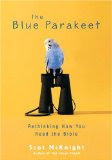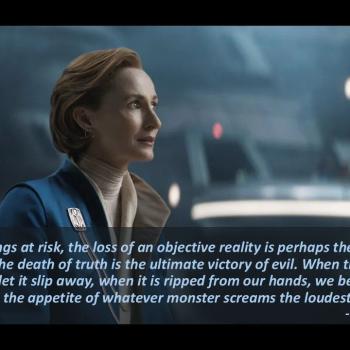Scot’s book is full of autobiographical details and anecdotes, beginning with the story of his coming to a personal faith. Soon after that, it seems, Scot saw more quickly than most of us that the claim being made by some Christians that they believe everything the Bible says and thus practice whatever the Bible says is (to use his term) “hogwash”.
When some encounter this discrepancy between what so-called “Bible-believing Christians” claim and the reality, they may have a crisis of faith. Scot, however, saw something else, something that eventually led to the writing of this powerful book. He saw in the discrepancy between some things that are in the Bible and what we believe and do today something appropriate, something that in fact emulated a Biblical model, although in many instances the underlying rationale was merely implicit and unarticulated.
This doesn’t mean that all discrepancies between what we find in the Bible and what we believe and do are good. But throughout the Bible we encounter dialogue and the practice of discernment, as one author, community or generation interacts with another, and does not always reach the same conclusion. This is appropriate, Scot argues, because God speaks to each generation in a unique way. To quote the book, “it is impossible to live a first-century life in a twenty-first century world.” And so the approach to the Bible that acknowledges that “that was then, this is now” is not merely a convenient cop-out but acknowledgement of a “bedrock reality.”
Making sense of the underlying rationale for how we discern what is of ongoing relevance in the Bible and what is not, and how this leads different Christians and communities to diverse conclusions and practices even as was the case and we see expressed in the Bible’s own diverse witness itself, became a lifelong quest for Scot. All readers of the book will be grateful for what Scot shares, as it is deeply personal, profoundly insightful, authentically Christian and ultimately Biblical.
It is another personal anecdote that explains the book’s title, the story of a blue parakeet, someone’s escaped pet, that came and made its home for a while in Scot’s yard. The initial reaction of other birds was fear, but then this newcomer was embraced in ways that changed the dynamics of “birddom” in his yard. The passages in the Bible that do not fit with our preconceived notions are like blue parakeets. If we do not ignore them, silence them or drive them away, they can change us in powerful and important ways.
Scot surveys a number of common “shortcuts” that people take with the Bible, which he considers inadequate. These include the approach that thinks we simply need to retrieve information from the Bible and bring it directly into our time as is; the approach that treats as most important the “puzzle”, the theological system, that one puts together using the pieces provided by or hidden in the Bible; the approach that treats the Bible as a Rohrshach inkblot; and a number of others. Emphasizing that we have not been given a theological system in the Bible but story, Scot goes on to consider the individual Biblical authors’ contributions as “wiki-stories” of the one underlying story. This meta-story which he discerns (perhaps in a way that not all would find persuasive) begins with creation and fall, the fragmentation of our original unity, and the move to restore the broken image of God.
Scot speaks in a way that addresses powerfully the failure of “Bible-believing Christians” to really come to grips with what is going on in the Bible, which often leads them to deny that they are “picking and choosing” because they are persuaded they should not do so. But Scot shows for instance how the early Church discerned that circumcision, which was an absolutely clear-cut commandment required not merely of biological descendants of Abraham but anyone incorporated into his family (Genesis 17:9-14), need not be imposed on Gentile Christians. The early Church, in other words, discerned that something in God’s Word ought to be set aside.
The latter part of Scot’s book if focused on using the issue of women in ministry as a concrete example of his approach, worked out in greater detail. After looking at WDWD (What Did Women Do?) in the Bible, and considering examples of women as leaders in ancient Israel, Scot acknowledges that one could easily argue “that was then, this is now”, a principle that potentially can cut both ways. And so attention is given to the trajectory of the underlying story he has discerned, which aims at restoring original unity. Also brought into the discussion is the way Paul treated matters of dress, gender roles, and the like in pragmatic terms, asking what the affect would be on the reputation of the church in the eyes of those outside. As a result, Scot argues that the blanket refusal by some churches and denominations to allow women to do things they at least sometimes did in Scripture damages the witness of Christians. At the same time, he acknowledges that there may be cultural contexts other than our own where a different process of discernment, different issues and a different practice would be appropriate.
The Blue Parakeet not only makes important points, but does so with impressive precision, insight and gentleness. It is hard to imagine how one could do a better job of mediating the depth and detail of knowledge Biblical scholarship has to offer to the Christians who claim to consider the Bible important, and yet often have only a superficial grasp of what the Bible is and what it contains. The Blue Parakeet articulates its message in a manner particularly accessible to those who consider themselves “Bible-believing Christians”. But even for readers outside that category, who may already be used to wrestling with difficult questions in relation to their faith and the Bible, the honesty and the seriousness with which Scot engages both the Bible and contemporary issues will make him a welcome participant in a broader dialogue. For such readers, there may be unanswered questions they would want to ask of Scot, but there will still be a great deal they can appreciate in what Scot does say.
So thank you, Scot, for writing this book. I hope that as a result many will stop ignoring or running from “blue parakeets” and discover the transformative power that can be unleashed simply by acknowledging their existence and listening to what they have to say.













